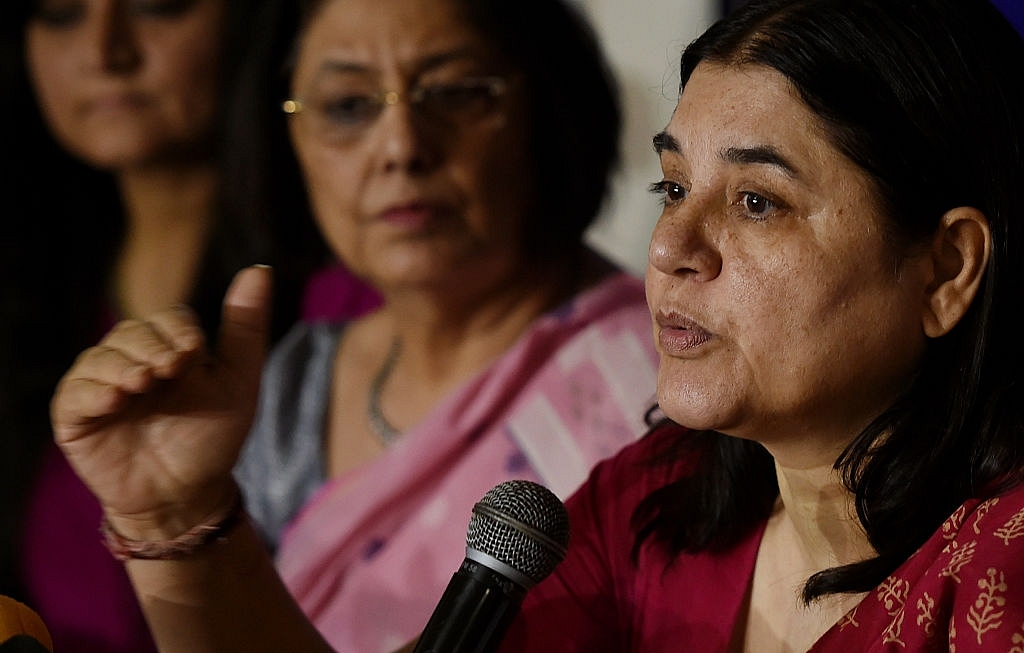Politics
Draft National Policy For Women: A Step In The Right Direction
- It’s not game-changing, but is a very important statement of the government’s vision and intent for women’s rights

Maneka Gandhi (MONEY SHARMA/AFP/Getty Images)
Women’s empowerment is not just a catchphrase to be trotted out by glib politicians and flag-waving feminists. It is an essential contributor in the development of a nation — a fact that is recognised by all governments, especially governments of developing countries, where so many women continue to be trapped in traditional gender roles and are never able to realise their full potential. India does have a raft of laws, policies and schemes to ensure the social, economic, and political uplift of women. Even so, women’s empowerment in this country has been patchy at best, often hamstrung by a range of social, cultural and infrastructural roadblocks.
Recently, Minister for Women And Child Development Maneka Gandhi released the Draft National Policy for Women, 2016, in an effort to put out a single, comprehensive document that brings together a gamut of issues critical to the progress of Indian women and the ways in which they might be actualised. This replaces the previous national policy for women, which was formulated in 2001(and has rarely been heard of since). Though it is a draft, and therefore, essentially work-in-progress, on the whole, it’s a commendable attempt to set out goals, policy parameters and an action plan to usher in equal opportunity for women in every sphere of life.
What’s more, it invites comments and suggestions from the citizenry, thereby raising hopes that the final document will reflect the voices and aspirations of Indian women themselves.
One key statement in the draft policy is that its overall objective is to achieve women’s empowerment not just through benefits and entitlements, but by “creating an enabling environment in which women can enjoy their rights”. The emphasis on a rights-based approach is significant. Implicit in it is the recognition that in today’s world, more and more women are not only aware of their constitutional right to be equal partners in society, but are also keen to assert them. They are less impressed with favours, more insistent on claiming what is theirs.
The 24-page draft policy sets out a detailed plan of action for the mainstreaming of women in areas such as health, education, economy, governance and many others. There are the usual nostrums on bringing down India’s naggingly high maternal mortality rate, boosting nutrition for girls and women, protecting their reproductive rights, ensuring adolescent girls stay on in school, improving child sex ratio, preventing female foeticide, eliminating gender wage gap, skill development, ensuring safety for women at home and outside, involving men and boys in gender sensitisation efforts and many others.
But the policy also comes up with some not so usual, but no less important, objectives. For example, shifting the burden of family planning from women to men by launching programmes for the sterilisation of men, geriatric care for women above 60 (who account for 8.4% of the population) or measures to free up women’s time spent in unpaid work through time-saving technologies, infrastructure, child/parental care services so that they can venture into paid work if they so choose.
The draft document is also in sync with the times in that it emphasises the need to create opportunities for single, separated, or divorced women, evolve strategies to protect women from being duped or harassed online, and safeguard the rights of those who resort to artificial reproductive technologies — surrogate and commissioning mothers.
Critics have been grumbling that the draft policy is nothing but high sounding verbiage, describing it as a regurgitation of standard issue goals for the uplift of women, with no clear roadmap for implementing them. There is, for example, that old promise of 33% reservation of women in Parliament, a promise every government likes to make, but none delivers on. And yes, many of the objectives do carry a tired sense of deja vu. However, just because some goals are regularly articulated does not mean that they are less relevant.
To me, the biggest lacuna in the draft document is that it fails to refer to the problem of marital rape. Earlier this year, Maneka Gandhi had stated that Indian society was not ready to criminalise marital rape. The draft policy offered a chance to jettison that preposterous argument. But clearly, the government continues to turn a deaf ear to the cries of women who face this intolerable violence in their bedrooms.
But other than that, the Draft National Policy for Women is a step in the right direction. Indian women have been breaching one constricting social norm after another. In recent weeks and months the courts have struck down the bar on women’s entry into certain places of worship and upheld a single woman’s right to not have to reveal the name of her child’s father in a passport application. Change is in the air, slowly chipping away at patriarchy’s stranglehold on society. At a time like this, a 360 degree policy framework for women would not only consolidate the momentum of change, but also power it ahead.
(Post your comments on the draft policy here)
Introducing ElectionsHQ + 50 Ground Reports Project
The 2024 elections might seem easy to guess, but there are some important questions that shouldn't be missed.
Do freebies still sway voters? Do people prioritise infrastructure when voting? How will Punjab vote?
The answers to these questions provide great insights into where we, as a country, are headed in the years to come.
Swarajya is starting a project with an aim to do 50 solid ground stories and a smart commentary service on WhatsApp, a one-of-a-kind. We'd love your support during this election season.
Click below to contribute.
Latest